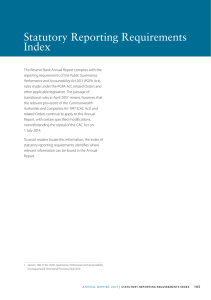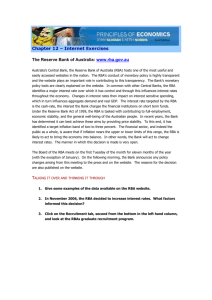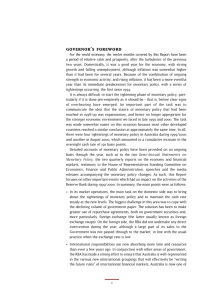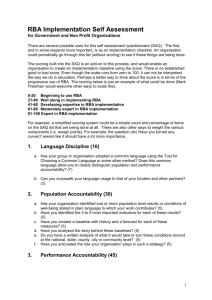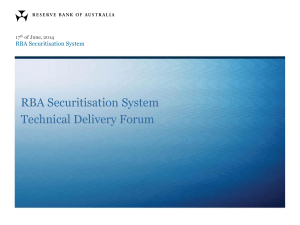the evolving structure of the rba
advertisement
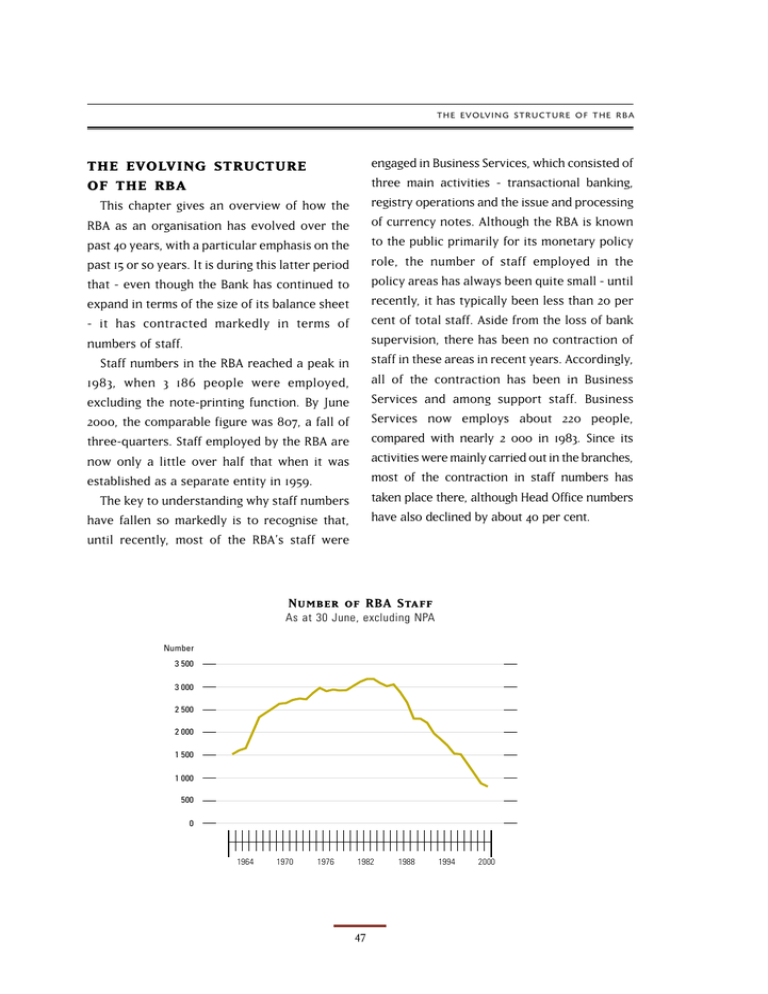
T H E EVO LV I N G ST R U C T U R E O F T H E R B A engaged in Business Services, which consisted of three main activities - transactional banking, registry operations and the issue and processing of currency notes. Although the RBA is known to the public primarily for its monetary policy role, the number of staff employed in the policy areas has always been quite small - until recently, it has typically been less than 20 per cent of total staff. Aside from the loss of bank supervision, there has been no contraction of staff in these areas in recent years. Accordingly, all of the contraction has been in Business Services and among support staff. Business Services now employs about 220 people, compared with nearly 2 000 in 1983. Since its activities were mainly carried out in the branches, most of the contraction in staff numbers has taken place there, although Head Office numbers have also declined by about 40 per cent. the evolving structure of the rba This chapter gives an overview of how the RBA as an organisation has evolved over the past 40 years, with a particular emphasis on the past 15 or so years. It is during this latter period that - even though the Bank has continued to expand in terms of the size of its balance sheet - it has contracted markedly in terms of numbers of staff. Staff numbers in the RBA reached a peak in 1983, when 3 186 people were employed, excluding the note-printing function. By June 2000, the comparable figure was 807, a fall of three-quarters. Staff employed by the RBA are now only a little over half that when it was established as a separate entity in 1959. The key to understanding why staff numbers have fallen so markedly is to recognise that, until recently, most of the RBA’s staff were Number of RBA Staff As at 30 June, excluding NPA Number 3 500 3 000 2 500 2 000 1 500 1 000 500 0 1964 1970 1976 1982 47 1988 1994 2000 R E S E RV E B A N K O F AU ST R A L I A Staff in Business Services banking 1983 1990 2000 Change 855 655 115 -740 registry payments settlements* 440 165 5 -435 45 45 note distribution 655 450 55 -600 total 1950 1270 220 -1730 * Payments Settlements Department was established in 1998 to operate the real-time gross settlement system and the Reserve Bank Information and Transfer System (RITS) able to conduct the Commonwealth business (banking and registry) with far fewer people explains most of the reduction in total staff numbers, and is the reason why this reduction was concentrated in the branches. Another more recent factor has been the Commonwealth Government’s competitive neutrality principles, which require that the prices which the RBA charges customers fully reflect commercial criteria. At the same time, Government agencies have had to put their banking business out to tender, so the RBA has had to compete with other providers. In addition to the reductions in the RBA’s business service functions, there were also staff cut-backs involved in regulation and in internal support functions. The loss of Exchange Control Department in 1983 and Bank Supervision Department in 1998 were obviously important, but there were others as well, including Rural Credits Department and a significant number of staff whose job was to monitor developments among non-bank financial intermediaries. These reductions have been only partly offset by adding new functions, so that the net reduction in jobs due to loss of functions was about 270 staff. Obviously, with far fewer staff in the “front line”, the need for internal support such as personnel, accounting, auditing and facilities An important factor behind the changes was the decline in banking activities for State governments. When it was separated from the Commonwealth Bank, the RBA retained the banking business of both the Commonwealth Government and a number of State governments. Although banking for State governments was not a core central banking function, State governments were big customers and they formed a significant part of the economic foundation on which the RBA branches were based. Except for Sydney and Melbourne, branches depended heavily on their State governments as customers. As State governments took their business elsewhere, it had a profound impact on the volume of work at the branches. Of even more importance were changes in technology. Transactional banking and registry services were essentially large-scale, clerically based processing activities, and hence were very labour-intensive. They were also quite decentralised with, for example, separate registries maintained in each State. As technology improved, more and more clerical processes were automated, direct entry replaced cheques and better communications allowed one centralised account or registry to replace six separate ones. As a result, staff numbers were sharply reduced. The combination of losing State government business and being 48 T H E EVO LV I N G ST R U C T U R E O F T H E R B A Rba Operating Costs* RBA1986/87 Operating Costs* = 100 1986/87 = 100 Index 140 Nominal 120 100 80 60 40 20 0 140 Real 120 100 80 60 40 * Figures for 1999/2000 exclude direct costs associated with currency distribution specifically for Y2K reasons. Total 20 Staff 0 87/88 90/91 93/94 96/97 99/00 because the reductions in staffing have occurred disproportionately at the lower clerical levels. Since 1986/87, total costs have fallen by 14 per cent, which is less than the fall in staff costs. The difference is partly due to the greater use of technology and partly to outsourcing. After adjusting for inflation, these falls in costs are a good deal larger, with staff costs down by 55 per cent and total costs by 45 per cent. The following sections give more details on developments in individual areas of the RBA. management was correspondingly reduced. In addition, a number of service functions which were formerly performed by the Bank’s own staff were outsourced. In most cases, the outsourcing was in response to lower volumes, but in some it was also because the in-house operation was not meeting industry “best practice”. These changes have been reflected in a significant reduction in the Bank’s staff costs, which are now about 30 per cent lower than in 1986/87. Staff costs have not fallen as much as staff numbers because average salaries have risen in line with the rest of the economy, and 49 R E S E RV E B A N K O F AU ST R A L I A larger financial institutions, with a desk-top banking facility for smaller institutions. Over time, the RBA also developed new systems to facilitate retail payments to, and international transactions by, Government agencies. Now, more than 80 per cent of the RBA’s transactions are handled electronically, compared with virtually none less than a decade ago. In some cases, such as the automation of banking systems, innovation had an immediate impact on staffing but the full impact of other changes, such as the introduction of GDES, was spread out over time. GDES itself has been refined to deliver more efficient transactional services while the administrative efficiencies, which GDES and other new systems made possible, took time to become apparent. In addition to technological change, to which all financial institutions have been subject, the loss of a number of customers, including State governments, has also taken its toll on RBA staff levels. The intensification of competition (i) Banking Services Transactional banking has seen the most pronounced decline in staffing. This has been the result of the continued application of technology, aimed at improving efficiency and reducing costs for customers, as well as the reduction in demand for banking services. The progressive replacement of paper-based banking transactions with cheaper and more efficient electronic systems began with electronically delivered welfare payments and the computerised processing of cheques early in the 1980s. This was followed by the automation of banking accounting systems and the electronic transfer of banking information with other financial institutions. The RBA’s development in 1991 of the Government Direct Entry System (GDES) made electronic payments on behalf of Government agencies easier, cheaper and quicker. This was achieved by establishing a network of communication links with major Government agencies and Banking Transactions g Millions 250 200 150 100 Paper 50 Electronic 0 83/84 85/86 87/88 89/90 91/92 50 93/94 95/96 97/98 99/00 T H E EVO LV I N G ST R U C T U R E O F T H E R B A has occurred in the context of the Commonwealth Government’s competitive neutrality principles. These require the RBA, in areas in which it competes with private sector suppliers, to achieve a commercial rate of return, pay taxes, observe the same regulatory framework as applies to private competitors and operate with commercial transparency. These principles provided a strong incentive for the Bank to ensure that it was not incurring any unnecessary expenses. Although the principles were formally introduced in 1997, the Bank had anticipated them and moved to run its separate businesses on fully commercial lines from the mid 1990s. As discussed in the previous chapter, the Commonwealth Government moved a step further in 1999, devolving responsibility for transactional banking to individual Government agencies, and requiring that these agencies market-test their banking arrangements. (ii) Registry and RITS The RBA’s registry business has also been transformed from a labour-intensive, paperbased operation to one heavily dependent on technology; at the same time, it has faced a dramatic decline in demand for its services. The registry currently holds 21 400 stockholder accounts, compared with 315 000 in 1990, while the annual volume of trades through the registry has declined over the same period from about 80 000 to about 2 500. The turning point for the registry business came in the mid 1980s, when the Commonwealth Government changed its pattern of debt issuance by ceasing to issue bearer securities in 1985 and Australian Savings Bonds (ASBs) in 1988. Registry systems were also automated around this period. The demise of the ASB, in particular, led to the almost complete cessation of demand for registry services by households. After the introduction of the Reserve Bank Transfers of Commonwealth Government Securities Thousands of transactions Thousands 250 200 150 100 Registry 50 RITS 0 89/90 91/92 93/94 95/96 51 97/98 99/00 R E S E RV E B A N K O F AU ST R A L I A of note-processing and steps taken to identify, and cut, unreasonable costs. The absence of any charge to banks for note-processing and distribution services, and the RBA’s involvement in retail supply of notes and in coin processing, had encouraged overuse of such services, adding to its costs. The introduction of high-speed noteprocessing machines in the first half of the 1980s led to a higher quality of notes in circulation, along with some reduction in note handlers. Computerisation of clerical functions led to some efficiencies but the need to move cash physically under secure conditions limited the application of technology compared with banking and registry. In the late 1980s, the RBA introduced a charge for its note-bag distribution service to banks’ branches as a way of recouping some of the costs, and to influence banks’ demand for note-processing, although a full charge was levied only in 1996. The transfer of coin-handling to armoured car companies in 1987 resulted in a large fall in RBA staff numbers. In 1998, the RBA also withdrew from retail note-distribution activities, which had a further significant impact on staffing. Under the new arrangements, the RBA stores a stock of notes at depots of armoured car companies, which distribute these notes to meet customers’ orders. These arrangements are more efficient and cost-effective than in the past, and are in line with the objectives of competitive neutrality policy. The introduction of polymer notes in 1992 also increased productivity in note issue and distribution. These notes have a longer life, are cleaner and less susceptible to counterfeiting Information and Transfer System (RITS) - which involved electronic transfer of securities and the consolidation of the holdings of professional traders of CGS in a single registry account - demand from the wholesale markets for registry services also virtually disappeared because RITS performed the same task so much more efficiently. In the late 1990s, central borrowing authorities of two States, previously customers of the RBA, began to use the services of a private provider. In contrast with the registry, the RITS business has enjoyed strong growth in market activity, with transfers through RITS increasing, in net terms, from about 40 000 in 1991/92 to about 117 000 in the past year. The decline in RITS turnover from its peak in 1996/97 mainly reflects the reduction in CGS on issue due to the run of budget surpluses. More fundamentally, the reduction in staff numbers in the registry business was the consequence of an improved approach to debt management - through the elimination of bearer bonds and ASBs and Australia’s commitment to establishing high standards in securities settlement through RITS. Although there is now only a small fraction of the staff formerly employed in the combined registry and RITS areas, the service provided is much better and fully in line with international “best practice”. (iii) Note Issue Note issue is a core central banking function and it is not contestable by the private sector. Note distribution, however, is subject to competitive neutrality dictates. Staff reductions in this area initially followed the same pattern as in banking, with some early mechanisation 52 T H E EVO LV I N G ST R U C T U R E O F T H E R B A Until the past decade or so, the RBA’s branches were quite autonomous and contained their own administrative structures. These arrangements were appropriate when business services could be provided on a decentralised basis, but came under pressure as a consequence of computer technology and the pursuit of efficiencies and cost savings. For example, the introduction of the automated banking system and GDES, both of which operate on the Bank’s mainframe computer, directly reduced branch staff employed in manual banking processes as well as in computing support. As employment in branches fell and the RBA moved its business services to a more commercial footing, branch administrative functions became more difficult to sustain since their costs undermined its ability to compete. than paper notes and, accordingly, do not need to be checked as often for authenticity and wear and tear. Of the remaining 55 staff employed in the note issue function, about half are involved in administering the remaining wholesale cash distribution process, along with developing policy and conducting research on note issue matters, which are core functions of the RBA. The remainder are employed in noteprocessing operations. This activity will, in future, be conducted at the National Note Processing Centre at Craigieburn in Victoria (iv) Impact on Branches As explained earlier, the reduction in staff in the RBA’s business services has been concentrated in the branches, because this is where the majority of banking, registry and note processing and distribution activities were carried out. The number of staff in branches has fallen from about 1 950, at the peak in 1982, to about 50 now working in the two remaining branches in Adelaide and Canberra. Provision of Financial Services to State Governments (Year in which service ceased) state banking Northern Territory Tasmania Queensland Western Australia Victoria Australian Capital Territory South Australia New South Wales(c) registry 1986 1998 1995 1999 (a) 1999 (b) (a) (a) (a) (a) 1998 (a) (a) (b) 1997 branch closed in: 1997 1998 2000 2000 2000 1997 (a) Function never supplied by the RBA (b) Function still supplied by the RBA (c) The RBA’s banking and registry operations have been centralised as business lines in its Head Office but the branch for New South Wales closed in 1997. 53 R E S E RV E B A N K O F AU ST R A L I A important participant in the payments system; banks have always settled their obligations among themselves across accounts at the RBA and the efficient operation of the payments system was a necessary precondition for the effective implementation of monetary policy. Given this confluence of interests, the RBA in the late 1980s began to develop RITS, with the aim of bringing settlement arrangements for CGS up to world’s “best practice”. RITS was subsequently adopted as the most suitable platform for the real-time gross settlement (RTGS) system for high-value interbank payments which was completed in June 1998. The RBA has built up its staff numbers involved in operating the RITS and RTGS systems together. At the same time, the RTGS system brought the demise of authorised money market dealers - the group through which the Bank had traditionally carried out operations to implement monetary policy - and a small reduction in the Bank’s staff who had supervised their activities. In July 1998, the RBA was given a formal role in the governance of the Australian payments system, with the establishment of the Payments System Board with strong regulatory powers. A new department was established to service this Board. At the same time, the RBA’s responsibility for the stability of the financial system was confirmed by the Government. This involved a small addition to staff. Another change that has been evolutionary in nature is that the RBA has taken a more sophisticated approach to the management of its portfolio of financial assets, especially the foreign assets it holds as official reserves. This For many years, servicing State and Territory governments provided branches with a critical mass to supply banking services on a costeffective basis. However, once these customers moved their banking business elsewhere, the remaining business activities in these branches were too small to be viable. The decision to centralise Commonwealth Government banking operations in the RBA’s Head Office and Canberra branch will enable the Bank to exploit whatever economies of scale are available so that it can continue to deliver competitive services to its remaining customers. (v) Changes in Policy Functions Outside the business services area, some of the important changes in the RBA’s structure over the past two decades can be attributed to regulatory and institutional reform in Australia. Certain reforms had a direct impact on staff numbers, including: • the floating of the exchange rate and the abolition of exchange controls in December 1983; • the ending of the RBA’s subsidised lending to primary producers and the closure of its Rural Credits Department in 1988; and • the transfer of responsibility for bank supervision to APRA from July 1998. After financial deregulation in the early 1980s, the RBA had built up its capacity to supervise banks. Other changes in the RBA’s policy functions have been more evolutionary, generally in response to ongoing developments in financial markets and in the financial infrastructure. One such change has been the RBA’s greatly increased involvement in the payments system. The Bank has always been an 54 T H E EVO LV I N G ST R U C T U R E O F T H E R B A Changes in Policy Functions staff reductions Function Abolished Exchange Control Rural Credits Official Forward Exchange Authorised Money Market Dealers Non-bank Surveillance and Consumer Issues 180 13 6 4 21 Function Added Payments Policy RITS/RTGS System Stability International Relations “Regulatory” Functions Banking Regulation Bank Supervision staff increases 24 22 10 6 69 -1985 -1998 Risk Manangement Internal Audit Middle Office Total 65 65 55 413 17 144 also reflects reductions in paper-based transactions and the closure of the branches. In general, resources have been reallocated to issues that are likely to be significant for medium-term policy, and away from matters of declining relevance. As an example, the RBA ceased its detailed monitoring of the activities of non-bank financial intermediaries as their importance in the intermediation process declined over the 1990s. On the other hand, it has become more heavily involved in international deliberations on global financial policy in the wake of the Asian crisis. Staffing has been augmented accordingly. has for the most part been accommodated within existing resources or with only minor increases. An important exception, however, is that the RBA has committed additional staff to a “middle office” in Financial Markets Group to ensure that trading staff comply with risk parameters and that senior managers are informed in a timely way about risk positions and portfolio performance. This emphasis on risk management in general saw internal audit shift to a risk-based audit framework which focuses on the integrity of systems designed to control risks faced by the Bank, rather than checking the accuracy of individual transactions. The reduced number of staff in audit 55 R E S E RV E B A N K O F AU ST R A L I A (vi) Support Costs In the face of strong competitive pressures to ensure a low-cost service to its business customers, the RBA has for some time closely scrutinised costs which looked high or procedures which involved unnecessary duplication. In many non-core areas where the RBA had no comparative advantage, a benchmarking process showed that its cost structure and work practices were out of line with industry standards, offering scope for substantial cost savings through outsourcing. By 1997, the RBA had fully outsourced its building maintenance, cleaning, catering and security guard services. It has, however, taken a selective approach to outsourcing, weighing the costs and benefits on a case-by-case basis. After evaluating the costs of external providers, for example, the RBA “insourced” the management of its workers’ compensation arrangements and decided to retain mainframe computing services in-house. In general administrative areas, as well, staffing has been pruned in response to falling staff numbers overall, the impact of technology and, where possible, a sharper commercial focus. Staff numbers in Personnel Policy, Facilities Management, Financial Administration and Systems and Technology Departments have been reduced over the past decade, easing the burden of overheads on business areas. Overall, staffing in the corporate support area has fallen by about 60 per cent from its peak in the mid 1980s, to a level of about 330 at present. Selected Reductions in Support Staff Support Activities Ancillary Staff (a) 175 Corporate Support 15 Facilities Management 35 Financial Administration 24 Legal Services 4 Personnel Policy 10 Systems and Technology 10 273 Outsourcing (b) Building Maintenance 30 Catering 26 Cleaners 79 Security Guards 116 251 (a) Cleaners, messengers, security guards, chauffeurs, storemen (b) Staff reductions in addition to those identified above The RBA in 2000 The progressive restructuring of the RBA has seen its focus sharpen toward its core functions. This is reflected in staff numbers: for the first time in the RBA’s history, there are now about as many staff employed in the core policy areas - of monetary policy, financial system stability and payments systems - as provide business services or corporate support. Over recent years, apart from the transfer of bank supervision staff to APRA, staff numbers in the core policy areas have been quite stable. 56 T H E EVO LV I N G ST R U C T U R E O F T H E R B A This is against a background of growing demands in the policy sphere. The marketoriented implementation of monetary policy, the introduction of an inflation-targeting framework and the RBA’s responsibility for financial system stability, have put a premium on the Bank’s policy analysis and have led to greater pressure on the Bank to be transparent and accountable. Like other policy agencies, the RBA has devoted considerable resources to conducting analysis and preparing advice. The volume of regular written material emanating from the RBA on the economy, financial markets and monetary policy has increased greatly over the past ten years or so. The greater workload of the policy areas has been accommodated within a largely stable number of staff by making greater use of technology. The proportion of clerical staff in these areas has fallen considerably over the past 15 years. In contrast to other agencies, the capacity to conduct operations in financial markets is unique to a central bank. The operational and policy roles are closely linked since a central bank’s main task is the formulation and implementation of monetary policy. Notwithstanding the reduction in overall staffing, the scale of the RBA’s policy-driven transactions has increased strongly over the past decade, meaning that its role as a participant in the money and foreign exchange markets has increased. Given that its balance sheet has continued to grow (currently to a level of around $55 billion in assets), the RBA is wellplaced to carry on significant operations with the private financial system and to meet its policy objectives. Number of RBA Staff As at 30 June, excluding NPA Number 2 500 2 250 2 000 1 750 1 500 1 250 1 000 Customer services 750 Corporate support 500 250 Core policy 0 1976 1979 1982 1985 1988 57 1991 1994 1997 2000

